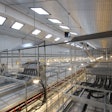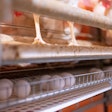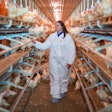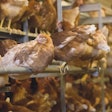
The Foundation for Food and Agriculture Research (FFAR) awarded three grants totaling $1.4 million to Purdue University, University of California, Davis (UC Davis) and University of Edinburgh, respectively, to improve the health and productivity of egg-laying hens.
The three grant awards are for innovative proposals for research to reduce keel bone fractures in egg-laying hens. Bone fractures, which cause pain and decrease egg production, are one known challenge to raising hens in cage-free housing systems and are particularly prevalent in the keel, or breastbone.
Based on U.S. Department of Agriculture estimates of the number of hens needed to meet existing cage-free pledges, including pledges by all top 25 U.S. grocers, this research has the potential to improve the welfare and productivity of approximately 225 million hens by 2025.
“The Foundation for Food and Agriculture Research is pleased to support innovative approaches to reducing bone fractures in egg-laying hens, a phenomenon that harms both productivity and hen health,” said Sally Rockey, Ph.D., FFAR executive director.
“Today’s farmers and ranchers face new challenges arising from a changing production environment, and cutting edge research remains critical to providing producers with science-based solutions to those challenges,” she added.
University leaders in study
Ian Dunn, Ph.D., a research scientist at the University of Edinburgh’s Roslin Institute, and collaborators at the major poultry genetics companies Hy-Line and Lohmann Tierzucht, will lay the groundwork for breeding hens with stronger bones by developing a novel x-ray based measurement system adapted for on-farm use.
Darrin Karcher, Ph.D., Purdue University assistant professor and Extension specialist, along with collaborators will conduct research to determine the impact of nutritional interventions on the gut microbiome in addition to management interventions that help producers to reduce keel bone fractures in laying hens housed in cage-free systems.
Maja Makagon, Ph.D., UC Davis assistant professor, will lead a team of collaborators from UC Davis, University of Bristol, University of Bern and Iowa State University. The team will explore the impacts of poultry housing design, particularly vertical space, on the prevalence of keel bone injuries in egg-laying hens.
Previous studies done on the issue
Dr. E Ernest Pierson wrote in an article for WATT Global Media: “The selection of performance traits in laying hens (egg production and egg weight) have resulted in the need to feed for increased structural integrity. For example, changes in egg production husbandry practices, such as alternative housing systems and the use of perches in the laying house, have created higher incidence of keel bone fractures.”
Pierson explained that while the industry has improved in terms of feed products to gain desired results (i.e. leg strength, breast quality, ect.) more research is needed. It is already known that certain vitamin supplements impact bone quality. However, “More research will be needed to better understand the optimal levels of dietary magnesium and other minerals in phytase-containing poultry diets. The importance of cost-effective feed additives such as highly reactive MgO which can benefit skeletal strength and integrity will only increase in the future,” Pierson wrote.
Another research study done showed the majority of keel bone damage originates from collisions with perches inside the layer house. Makagon discussed the results of the study on April 19, 2017 as part of the Egg Industry Center Egg Industry Issues Forum in Columbus, Ohio.
The study, conducted by students and professors from UC Davis, Purdue University, the University of Bern and Michigan State University, analyzed keel damage in an enriched cage environment. Makagon said the study contributes to existing literature on the topic by examining the relationships between the development of keel bone damage, the types and magnitudes of impacts experienced at the keel by hens housed in enriched colony systems and behaviors associated with these impacts.
Makagon said more than 80 percent of the impacts greater than 20 gravitational force (G) were due to collisions with objects inside the enriched cage. The strongest collisions were greater than 100 G of force. Specifically, 74 percent of collisions were with perches located inside the enriched colony and 30.5 percent of those collisions occurred while birds were ascending onto the perch. The study also determined the number of collisions – rather than the number of keel bone impacts, strength of impacts, or presence of previous fractures – was most likely to negatively affect keel bone integrity.

















